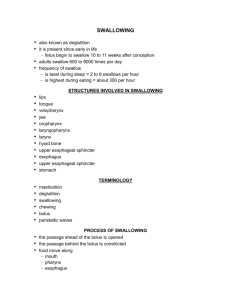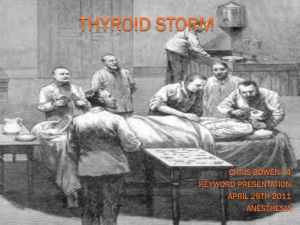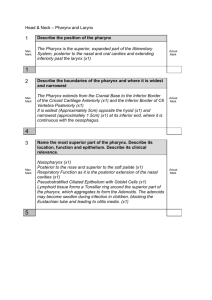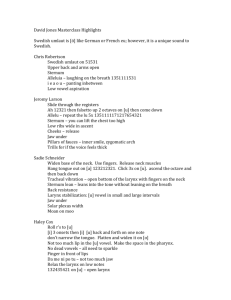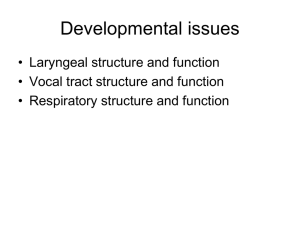soft tissue neck Chapter_15 online 2 24 2011
advertisement
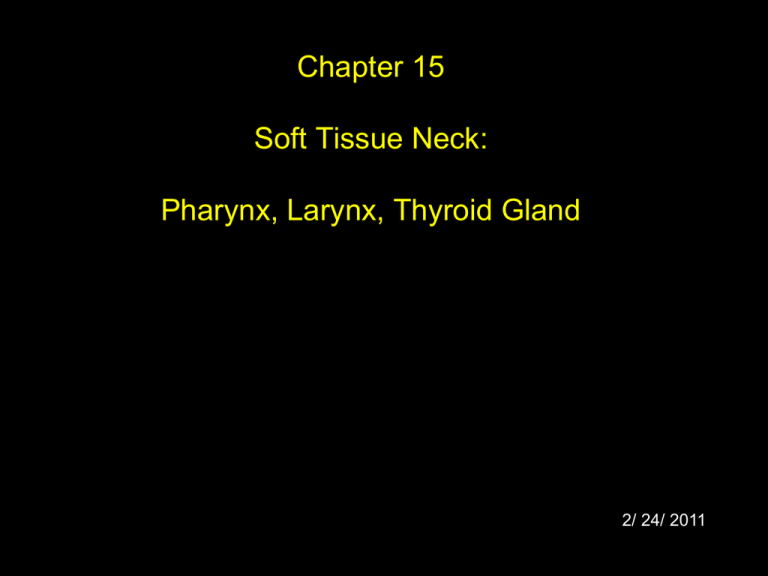
Chapter 15 Soft Tissue Neck: Pharynx, Larynx, Thyroid Gland 2/ 24/ 2011 Anatomy: Neck Region between skull and thorax Radiographically divided into: Anterior - soft tissues Posterior - bony tissues Anterior Part of Neck Principal structures: Upper respiratory parts (trachea) Upper digestive parts (esophagus) Thyroid gland Parathyroid gland Larger part of submandibular salivary gland Thyroid Gland 2 lateral lobes Connected by narrow median portion- isthmus Lobes located on sides of trachea from lower 3rd of thyroid cartilage to T1 Controls: how quickly body burns energy & makes proteins how sensitive body should be to other hormones) Left Lateral Projection Parathyroid Glands (Para: beside; near; alongside) Small, ovoid structures on posterior aspect of thyroid gland lobes (Adams Apple) 2 on each side Superior Inferior Only function: maintain body’s calcium level within very narrow range, so nervous system and muscular systems function properly Left Lateral Adam’s Apple Also known as laryngeal prominence Mosby items and derived items © 2007, 2003, 1999 by Mosby, Inc., an affiliate of Elsevier Inc. Slide 6 Women have Adam’s Apples Not as pronounced as men Cosmetic surgery to reduce size of a laryngeal prominence -chondrolaryngoplasty Surgery may change pt's voice and cause permanent damage & leave a visible scar performed in many types of gender reassignment surgery Pharynx Musculomembranous, tubular structure in front of vertebrae, behind nose, mouth, & larynx Serves as a passage for both food and air Subdivided into 3 parts: Nasopharynx Oropharynx Laryngeal Pharynx Larynx Organ of voice Part of respiratory system Air passageway between pharynx and trachea Vocal Cords Epiglottis Situated above larynx Said to prevent food from passing into larynx during swallowing 4 types of Radiographic Exams for Soft Palate, Pharynx, and Larynx This exams are largely obsolete, replaced by CT and MRI Palatography- investigate tumors of soft palate and cleft palate Nasopharyngography-demonstrates hypertrophy of pharyngeal tonsils and adenoids Pharyngography-performed to study the act of deglutition or? Swallowing Laryngopharyngography-determine exact site, size and extent of tumor masses Example of soft tissue study(Pharyngography) Thick, creamy barium sulfate suspension AP Pharynx Take AP and lateral images during swallowing Fluoroscopy often used due to rapid motion of swallowing Lateral Pharynx Contrasts Negative - Air Positive- Barium or iodinated Oil Respiratory and Stress Maneuvers Quiet inspiration- simply breathe in -tests abduction of vocal cords Normal (expiratory) phonation- deep breath in, exhale making high pitched e-e-e or low pitched a-a-h -tests adduction of vocal cords Inspiratory phonation- AKA- aspirant manueverexhale then breath in making e-e-e- sound -demonstrates laryngeal ventricle Respiratory and Stress Maneuvers cont’d Valsalva’s maneuver- forced expiration against closed glottis -tests elasticity and functional integrity of glottis Modified Valsalva’s maneuver- pinched nose, blow out and inflate cheeks -tests elasticity of laryngeal pharynx and piriform recesses

